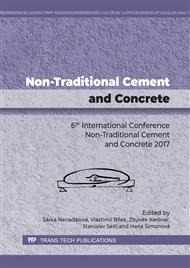[1]
M. Špak, I. Halaša, M. Šuster, O. Vojtechovský, Informácie o používaní popolčeka do betónu, Trnava: BetónRacio. (2012).
Google Scholar
[2]
A. Fernández-Jiménez, A. Palomo, Characterisation of the fly ashes. Potential reactivity as alkaline cements, Fuel. 82 (2003) 2259-2265.
DOI: 10.1016/s0016-2361(03)00194-7
Google Scholar
[3]
J.L. Provis, A. Palomo, C. Shi, Advances in understanding alkali-activated materials Cement Concrete Res. 78 (2015) 110–125.
DOI: 10.1016/j.cemconres.2015.04.013
Google Scholar
[4]
P. Duxson, A. Fernández-Jiménez, J.L. Provis, G.C. Lukey, A. Palomo, J.S.J. Van Deventer, Geopolymer technology: the current state of the art, J. Mater. Sci. 42 (2007) 2917–2933.
DOI: 10.1007/s10853-006-0637-z
Google Scholar
[5]
D. Bondar, C.J. Lynsdale., N.B. Milestone, N. Hassani, A.A. Ramezanianpour, Effect of type, form, and dosage of activators on strength of alkali-activated natural pozzolans, Cement Concrete Comp. 33 (2011) 251-260.
DOI: 10.1016/j.cemconcomp.2010.10.021
Google Scholar
[6]
A. Palomo, M.W. Grutzeck, M.T. Blanco, Alkali-activated fly ashes. A cement for the future. Cement Concrete Res. 29 (1999) 1323-1329.
DOI: 10.1016/s0008-8846(98)00243-9
Google Scholar
[7]
A. Buchwald, M. Weil, K. Dombrowski, Evaluation of primary and secondary materials under technical, ecological and economical aspects for the use as rew materials in geopolymeric binders, in: Proceedings of the 2nd Int. Symposium of Non-Traditional Cement and Concrete, (2005).
Google Scholar
[8]
A.M. Rashad, A synopsis about perlite as building material – A best practice guide for Civil Engineer, Constr Build Mater. 121 (2016) 338–353.
DOI: 10.1016/j.conbuildmat.2016.06.001
Google Scholar
[9]
Y. Luo, S. Ma, C. Liu, Z. Zhao, S. Zheng, X. Wang, Effect of particle size and alkali activation on coal fly ash and their role in sintered ceramic tiles, J Eur Ceram Soc. 37 (2017) 1847–1856.
DOI: 10.1016/j.jeurceramsoc.2016.11.032
Google Scholar
[10]
Y. Ding, J.G. Dai, C.J. Shi, Mechanical properties of alkali-activated concrete: A state-of-the-art review, Construction and Building Materials. 127 (2016) 68–79.
DOI: 10.1016/j.conbuildmat.2016.09.121
Google Scholar
[11]
N.K. Lee, K.T. Koh, G.H. An, G.S. Ryu, Influence of binder composition on the gel structure in alkali activated fly ash/slag pastes exposed to elevated temperatures, Ceram Int. 43 (2017) 2471–2480.
DOI: 10.1016/j.ceramint.2016.11.042
Google Scholar
[12]
G. Bumanis, L. Vitola, D. Bajare, L. Dembovska, I. Pundiene, Impact of reactive SiO2/Al2O3 ratio in precursor on durability of porous alkali activated materials, Ceram Int. 43 (2017) 5471–5477.
DOI: 10.1016/j.ceramint.2017.01.060
Google Scholar


